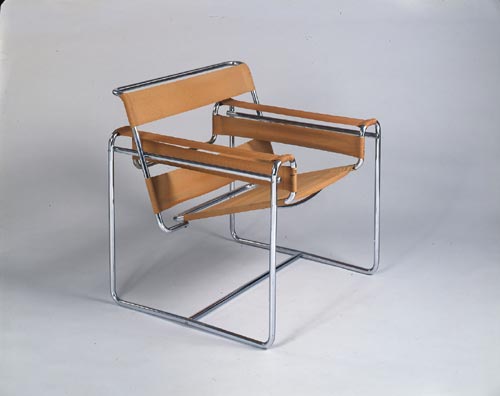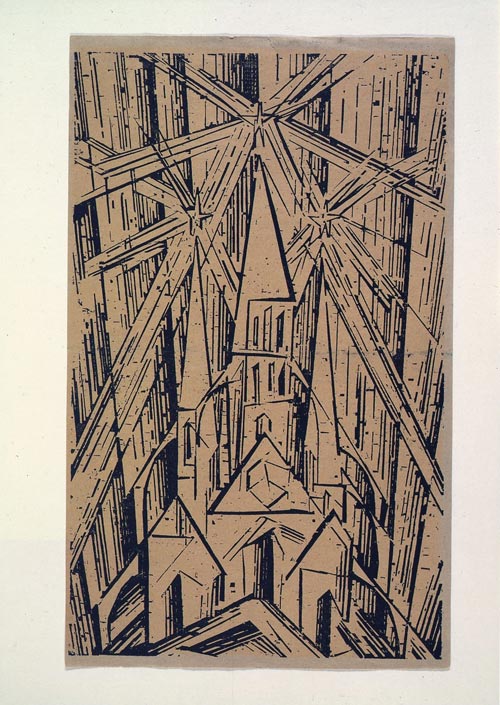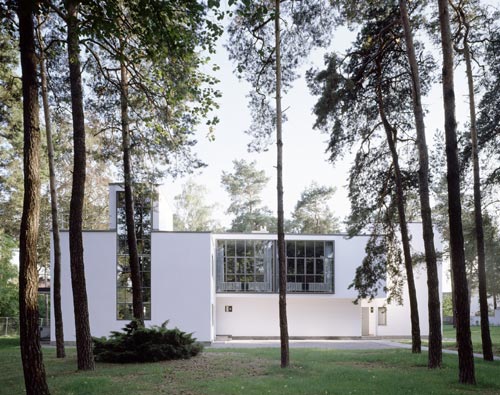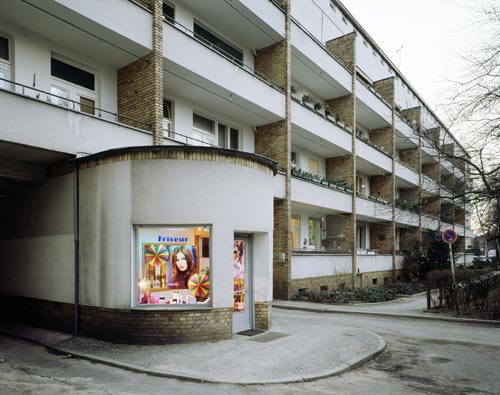

Architects, painters and sculptors must recognise anew the composite character of a building as an entity. Only then will their work be imbued with the architectonic spirit, which it has lost as 'salon art'.
Middlesbrough Institute of Modern Art.
23 November 2007-17 February 2008
Architects, sculptors, painters, we must all turn to the crafts. Art is not a 'profession'. There is no essential difference between the artists and the craftsmen. The artist is an exalted craftsman. In rare moments of inspiration, moments beyond the control of his will, the grace of heaven may cause his work to blossom into art. But proficiency in his craft is essential to every artist. Therein lies a source of creative imagination.1
The Bauhaus was at once a 'school, workshop, studio and laboratory', where Walter Gropius sought to forge a rare and new alliance between art and industry. The Bauhaus movement emerged as architects and artists began to rebuild war-torn Europe after the Great War. Gropius attracted artists such as Paul Klee, Wassily Kandinsky, Oskar Schlemmer and Lyonel Feininger.
[image3]
When the Bauhaus was founded in Weimar in 1919, the artists were committed to re-examine the very basis of art that would, in turn, touch every aspect of life. It was one of the most significant experiments in art in the twentieth century. The utopian spirit in post-war Germany gave rise to the belief that the artist could help to bring about new social conditions through the creation of new environments that became the focal point for such thinking in Europe in general. Gropius wanted to remove the barrier between artists and craftsmen. He wanted '...to create the new building of the future, which will embrace architecture and sculpture and painting in one unity and which will rise one day towards heaven from the hands of a million workers like the crystal symbol of a new faith'.2
[image4]
Bauhaus 1919-1933 is at the Middlesbrough Institute of Modern Art (Mima). This is the first Bauhaus exhibition in Britain since the Royal Academy's show in 1968, dedicated to Walter Gropius, then an Honorary Royal Academician who lived in England between leaving Germany and settling in the USA. The Mima exhibition focuses on the ethos of the Bauhaus through an exhibition of paintings, drawings, furniture and design. A series of photographs of original Bauhaus architecture by Hans Engels is included in the show.
The Bauhaus was born with the Weimar Republic in 1919 and died in the hands of the Nazis in 1933; they described the Bauhaus flat roof as 'oriental and Jewish', the institution as a hotbed of Bolshevism. It was transported in a revised form to America where Gropius later settled. His own copy of the manifesto is one of the exhibits in the Mima exhibition. On the cover is Lyonel Feininger's famous Kathedrale woodcut - not a static or repressive gothic cathedral but a tremendously energetic, jazzed up image full of a dissidence and vision for the future. The image, like the Bauhaus Manifesto itself, was abstract and dynamic, liberated from the historically based teaching of the European art academies. Much of the Bauhaus vigour came as a consequence of Germany's defeat. Buildings would be imbued with considerably more significance - psychological, sexual and practical. The artist and architect would in Gropius's scheme take charge of the rebuilding of a battle-fatigued continent.
[image5]
In the Bauhaus, Walter Gropius combined two schools - Art and Crafts and Fine Art - into one building. He coined the name Bauhaus - House of Building. The allusion he made was to the medieval cathedral, the building which, in his view, would be the meeting place of all teaching in the visual arts. In his ideal institution art and design would become unified ideologically and in practical terms. 'The ultimate goal of the Bauhaus is the collective work of art in which no barriers exist between the structural and decorative arts. Artists and architects would work together towards the great goal of the "building of the future".'3 The Bauhaus embodied many ideas from the Viennese Sezession and Werkstätte, and from William Morris and the English Arts and Crafts Movement. Given the historical context, the Bauhaus became more fervent, more utopian than any of their precedents. It was also on a significantly larger scale. The Bauhaus departed from their precedents in that they sought to define an educational system through the institutionalised training of artists, architects and designers. Indeed, the pedagogical methods of Klee, Kandinsky and Itten had a major impact in the teaching of art and design all over the world throughout the twentieth century. Craft at the Bauhaus was more greatly influenced by industrial design and machine aesthetics. The emphasis on converting craft to industry through the creation of prototypes for mass production reflects Gropius's left wing political sympathies. Bauhaus furniture is perhaps the most successful in this. The tubular chair designed by Marcel Breuer in 1925 is still in production today. Gropius's goals were clearly expressed in his teaching curriculum:
The culminating point of the Bauhaus teaching is a demand for a new and powerful working correlation of all the processes of creation. The gifted student must regain a feelin
g for the interwoven strands of practical and formal work. The joy of building, in the broadest meaning of that word, must replace the paper work of design. Architecture unites in a collective task all creative workers, from the simple artisan to the supreme artists.4
Oskar Schlemmer believed that it was in Gropius's vision that the Bauhaus developed its unique character and was, 'not restricted to any dogma, with an awareness of all that is new and topical in the world and with good motives for assimilating it. With these good motives for stabilizing it all, comes the reduction to a common denominator, the creating of a code. Hence the battle of minds, in the open or in secret, as perhaps nowhere else, a constant unrest, compelling the individual almost daily to take a stand on profound problems'.5
The programme, once established, changed and developed organically within the school. 'The Bauhaus was never the same, even though its basic character remained unchanged. Creative freedom was the climate which permeated everything and was imparted to all masters and students. The intimate contact with the present, service to mankind and society, humanism, in a word, is what gave the Bauhaus its vital impulses.'6
Given that painting had led the arts since 1900, Gropius appointed painters as teachers. The sculptor, Gerhard Marcks, was the exception. A comprehensive cultural entity was sought. A council of masters discussed all appointments but Gropius made all the final decisions. His judgement was independent of the accepted views of critics and museums who favoured expressionist artists such as Nolde, Chagall, Kokoschka and Die Brücke. Gombrich preferred abstract and cubist art for he saw that it was more compatible with his architectural aims.
With Kandinsky he appointed the discoverer of abstract painting who had left behind him the dynamic genial period of the 'blaue reiter' period and had turned towards tectonic construction.7
Gropius also chose Paul Klee, who was by no means recognised outside Germany at that time. Feininger was better admired than Kandinsky and Klee. Gropius's other choices were also impressive in that they did not have established reputations at the time of their appointment, but all became key artists of the twentieth century: Oskar Schlemmer, Johannes Itten, Josef Albers, László Moholy-Nagy and Marcel Breuer. Students at the Bauhaus took a six-month preliminary course which was made up of painting and elementary experiments with form; they were instructed in craft workshops - sculpture, carpentry, metal, pottery, stained glass, mural painting and weaving - the last headed by a rare female instructor, Gunta Stölzl (1897-1983). Then they progressed to a three-year workshop training with two masters - an artist and a craftsman. They studied architecture in theory and in practice, and assisted in the actual construction of buildings.
The Bauhaus opened in Weimar in 1919 and then relocated to Dessau in 1925 after the leftwing Social Democratic Party, which had financed it, lost control of state schools to nationalists. Dessau was a middle-sized industrial city in central Germany. Here a purpose-designed building was made, a most ambitious project for Gropius, with workshops, a lecture room, a theatre, student accommodation and canteen facilities. The building was designed collaboratively with Gropius and his staff and students. In symbolic terms, and as a utopian experiment, the Bauhaus was greater than the institution itself. In terms of the influence all over the world, the Bauhaus served to disseminate an inspired and remarkable philosophy and teaching programme. Fiona MacCarthy observes:
This was a Modernist utopian project like no other. The completed Bauhaus, with its simple cubic forms and shimmering glass surfaces, was seen to have announced a new international architectural style. The unity was striking: the different functional elements came together to form an abstract geometry, as in De Stijl painting. To the Russian writer Ilya Ehrenburg, the building seemed 'cast of one piece like a persistent thought'.8
Germany between the wars gave birth to one of the most influential institutions in art practice, yet the political reality also destroyed it. Many staff and students at the Bauhaus were Jewish, and the philosophy behind abstraction in art was anathema to the Nazis. By 1931 the Nazis controlled the Dessau municipal council. The following autumn the Bauhaus was closed - windows were smashed, the building surrounded by police. A protest on an international scale prevented the building being completely destroyed. There were attempts to create a new Bauhaus in Berlin, in a disused factory, but soon after Hitler became chancellor. The Bauhaus represented almost everything that the Nazis abhorred in art, especially since they had the view that it represented a Jewish-Marxist conception of art. On April 11 1933 the police arrested 32 students, ending the Bauhaus in Europe.
By the bitter end in 1933, key staff had already left. Gropius had resigned in 1928, Klee and Kandinsky left in 1933, the same year that Albers emigrated to America. The Black Mountain College in Chicago benefited from the arrival of Bauhaus refugees such as Albers (see review of exhibition on this website). Moholy-Nagy established the New Bauhaus in Chicago in 1937. Both took Bauhaus teaching to America where it had a profound effect on courses in art schools there.
Gropius and his wife came to London in 1934, before moving to America, where he became chairman of the architecture department at Harvard University from 1938 to 1952. In London, a small community of émigrés established a presence at the Lawn Road Flats in Hampstead (see Richard Carr's article on this website).9 Britain's embrace of modernism in the 1930s was so poor that most of the Bauhaus members went on to America. A small number stayed, such as the master goldsmith from the Weimar Bauhaus, Naum Slutsky, who taught at Birmingham into the 1960s. British art schools, like those in America, were nonetheless infused with the spirit of the Bauhaus, through actual teaching methods and also through the optimistic sense that art students and their teachers enter in the creative journey at the beginning of their careers.
The Bauhus started much that we take for granted. A revolution in the art schools of this country began in the immediate post-war period with the reconstituted Royal College of Art (RCA). The new principal, Robin Darwin, was a painter. As at the Bauhaus, the professors were themselves practising architects, artists and designers; stars in their own spheres. RCA students were specifically trained for the emerging design professions. The ethos of the RCA - attuned to new technologies, self-confident, anarchic - quickly spread to other colleges. It was this Bauhausian energy and commitment in the art schools from the 1960s onwards that turned Britain from a predominantly literary culture to the visually alert nation we (sometimes to our surprise) now find ourselves to be.10
From the outside it might appear that the Bauhaus was a product of the political situation in Germany between the wars, and that the pedagogical methods that have survived are inspiring but solemn. What characterised the Bauhaus in its heyday was a surprising degree of absurdity and freedom that the solemn manifesto might obscure. Oskar Schlemmer's 'Triadic Ballet' is a long way from tubular steel furniture and industrial design, and yet it grew from the genius of the individual and the remarkable atmosphere and institution that was the Bauhaus. Less known than the industrial design and architecture that have shaped the modern world, the 'Triadic Ballet' is still occasionally performed today.
Oskar Schlemmer viewed three elements of the theatre; man in space, light in motion and architecture. He was not interested in a representational theatre, but a theatre of abstraction. He saw the life of our time as the product of mechanisation, and that impulse explains his insistence on reducing form and motion to the smallest number of shapes and movements. The function of costume, for Schlemmer was to emphasise the identity of the body or to change it. Costume in Schlemmer's view expresses the body's nature or it purposely misleads the audience regarding it. The 'Triadic Ballet' comprised three dancers, three musical movements and was a fusion of the three elements of dance, costume and music.
At the Bauhaus, theatre and stage design were taught with great flair and invention. Lothar Schreyer in 1922 established the ethos for work in the theatre.
Work on the stage is a work of art.
Work on the stage points to the unity of life
through the multiplicity of the living.
Unity is heralded by order in multiplicity.
Order is the law of the work of art ...
Work on the stage encompasses the world of
man. the stage produces life just as life
produces life. The message of the inner man
creates the inner man. Through the different
senses the work produces the one meaning:
redemption from contradiction through the
law. Law is the order of life which helps all
the living into life.11
Schlemmer encouraged his students to approach things as if the world had only just been created. He urged them to choose simplicity over pomposity or the verbose. His elementary method encouraged his students to appraise each stage of movement from the simplest and most minimal position. His teaching as with his own work, had a liberating effect as the ballet he designed:
Have as much awe as respect for any kind
of action of the human body, particularly on
stage, this special world of life, of make-
believe, this second reality in which
everything is enveloped by the radiance
of magic.12
The Bauhaus history, the idealism and energy invested in it, makes it a most moving place and phenomenon. Rayner Banham described the Bauhaus at Dessau as a 'sacred site'. He was referring to more than the building itself: its solemn history, the altruism of so many individuals who taught and attended there, and the sum of outstanding artistic achievement in many fields of the arts that has made it an international institution of profound importance.
Dr Janet McKenzie
References
1. Walter Gropius. Bauhaus Manifesto, 1919. Reprinted in:
Bauhaus, 50 Years. London: Royal Academy of the Arts, 1968: 13.
2. Ibid, p 13.
3. Ibid: 9.
4.Ibid: 9.
5. Ibid: 9.
6.Ibid: 9.
7. Ibid: 9. 8. Fiona MacCarthy. House Style. In: Review, Saturday Guardian. http://arts.guardian.co.uk/art/architecture/story/0,,2212350,00.html (last accessed 11 December 2007)
9. Richard Carr. Lawn Road Flats. In: Studio International Yearbook. New York: Studio Trust, 2004: 94-99.
10. MacCarthy, op.cit: 13.
12. Ibid: 89.



